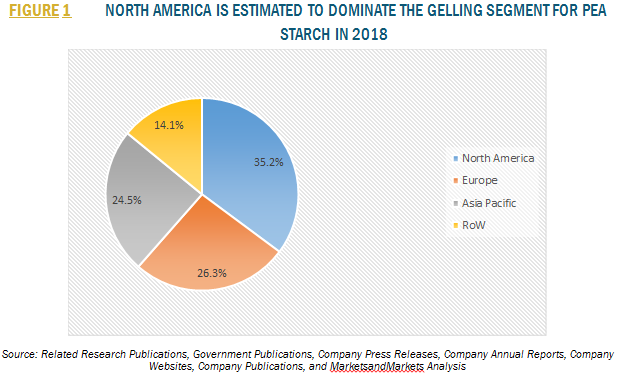Pea starches are carbohydrates extracted from peas for application in the food and feed industries. In addition, due to their biodegradable and renewable nature, they are increasingly being used as an alternative to fossil fuel components in various chemical applications, including detergents, cosmetics, and pharmaceuticals. They are stable under high temperature, and various pH levels and have good resistance to shearing. In addition, they are mostly used for the aseptic processing of food products such as sauces, soups, and meat products.
Pea starch stability is also used for enhancing the crispness in food products along with improving volume in various extruded snacks. Along with various nutritional properties, it is also used in products such as gluten-free and lactose-free solutions, low-calorie formulations, and allergen solutions, due to which it is widely used in the pet food industry.
According to MarketsandMarkets, the global pea starch market is projected to grow from USD 91.8 million in 2018 to USD 134.7 million by 2023. The market growth is attributed to the rise in demand for high-quality convenience food and beverage products.
What is driving the growth of the pea starch market?
- The rising demand for pea starch in various food and industrial applications
Pea starch offers various functions such as gelling, texturizing, binding, coating, thickening, and film forming. Due to its multifunctionalities, pea starch is used in various food applications, such as pasta, noodles, bakery products, confectioneries, soups, sauces, meat products, and poultry. It is also widely used in vermicelli as a binding agent. Pea starch is also a potential replacement for other starches in food and beverage applications as it is an economical option and offers a wide range of functions. In the pharmaceutical and cosmetic industries, pea starch is used for its gelling, thickening, and texturizing properties. With the rapid growth and changing trends in the pharmaceutical industry, the demand for pea starch is projected to increase. Companies such as Meelunie B.V. (Netherlands) and Parrheim Foods (US) are the major producers of pea starch, which cater to the pharmaceutical and cosmetic industries.

- The rapid growth in the corn ethanol industry has contributed to a significant increase in the prices of corn and ethanol, due to which producers are focusing on shifting from corn to low-cost alternatives such as pea starch, which in turn, contributed to the growth of the pea starch market. The production of ethanol by pea starch improves the fermentation rates and allows ethanol producers to expand the annual production capacity and decrease capital costs by increasing the number of fermentations per year.
- Starch granules, when heated in excess water above their gelatinization temperature, undergo irreversible swelling, resulting in amylose leaching into the solution. The changes that pea starch undergoes due to retrogradation are a major determinant to its functional properties for food and industrial applications and pose significant challenges to the food processing industry. For instance, it causes the staling of bakery products and the embrittlement of starch plastics, coatings, and adhesives. In non-food uses of pea starch such as in paper and adhesive applications or plastics, retrogradation affects the processing and final properties. Hence, it is one of the major restraints for the growth of the market globally.
- The pea starch market is witnessing significant demand in developing countries such as China and India, due to the rising awareness of healthy and natural ingredients in food products, along with the increasing production of food and feed products in these countries. Localizing operations can help in reducing costs and improving access to local distribution networks, thereby optimizing profit margins. Resources and labor are readily available at a cheaper rate in these regions. The local governments in China and India are providing incentives for multinationals to set up Greenfield ventures. The Indian government has declared major tax breaks to attract multinational investors. China provides special tax incentives over the usual tax holidays to encourage foreign investors.
Speak to Analyst @
https://www.marketsandmarkets.com/speaktoanalystNew.asp?id=78961382
The gelling segment is estimated to dominate the global pea starch market
Pea starch is used to maintain the texture of food and also to create texture in water-based products. Gelling improves the availability of starch for amylase hydrolysis. Hence, the gelling process for starch is used constantly in the food & beverage industry to make starch digestible and to thicken or bind food products. Pea starch as a gelling agent is used in various applications such as confectionery and feed due to the high availability of amylose. In addition, the gelling function helps to keep the nutrients in food and feed products intact. As pea starch has strong gelling capabilities, manufacturers are using it to produce various food products and meet consumer demands globally.

Based on region, the pea starch market is segmented into North America, Europe, Asia Pacific, and Rest of the World.
- North America accounted for the largest share with a value of USD 29.5 million in 2017. This market is projected to grow at a CAGR of 8.4% during the forecast period. Emsland Group (Germany), Cosucra Groupe Warconing SA (Belgium), Parrish and Heimbeckar, Ltd. (Canada), Puris Foods (US), and Axiom Foods, Inc. (US) are a few key players that occupy a significant share in the global market for pea starch.
- The major factors driving the demand for pea starch in North America are the growing awareness of animal nutrition and the presence of a large number of pea starch companies in the region.

